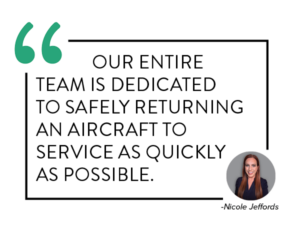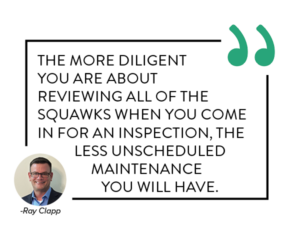Planning for Scheduled and Unscheduled Aircraft Maintenance
Every aircraft faces the challenges of maintenance – both scheduled and unscheduled. The Global MX crew works proactively to keep your aircraft in the air where it belongs and to minimize downtime. This is the backbone of Global MX’s mission as your on-call aircraft maintenance partner.
According to Ray Clapp, Global MX’s Chief Inspector, “DOMs will know their fleet and their jet aircraft. Scheduled maintenance will include calendar items like 24 and 96-month inspections, 5000 landing inspections, and all the way down to 500-hour inspections.”
“Every Part 135 operator has some sort of CAMP program that tracks that for them,” added Global MX VP Maintenance Nicole Jeffords. “So, therefore, they know when their inspections are coming up.”
 These are just some of the projects routinely handled by the expert technicians on the GMX shop floor.
These are just some of the projects routinely handled by the expert technicians on the GMX shop floor.
Owners of GA aircraft also look to GMX for annual inspections, 100-hour inspections, and other scheduled maintenance.
“Progressive inspections are primarily used by 135 operators…both jets and turbo props,” said Jeffords. “Our entire team is dedicated to safely returning an aircraft to service as quickly as possible.”
GMX professionals play it by the book when it comes to inspections – literally.
“The manufacturer’s maintenance manual gives a complete list for an inspection,” said Clapp. “For instance, Rolls Royce or Gulfstream will provide an inspection list. It tells you exactly each area to inspect, what panels to take off, and what to look for.”
Testing, checks, and limitations are key according to Clapp. “Components are tested.
Panels are removed and corrosion inspected. We perform operational checks. When it’s necessary, we refer to manufacturer specs to know if we’re within tolerance.”
Based on those inspections, GMX generates squawks for the airframe owner.
Jeffords continued, “Now you have a list of corrective actions. We then speak to the customer about the squawks that we found and which ones are airworthy requirements or Part 135 requirements. Or perhaps the aircraft was scratched or dented.”
Customers count on GMX for next steps in addressing squawks arising from the inspection.
“Some are airworthy items, and they must be done,” said Clapp. “Some squawks come down to the customer’s choice since they’re not going to affect the return to service.”
When it comes to unscheduled maintenance, the GMX takes pride in fulfilling our promise of being “Your on-call aircraft maintenance partner.”
“Ninety-nine percent of the time, it’s going to be the pilot who finds an unscheduled maintenance event,” said Clapp. “And that would be if there’s a defect or failure of a system. For Part 135, that’s typically an AOG (aircraft on ground) situation.”
Unscheduled maintenance covers a variety of happenings including issues with the bleed air system, tires worn beyond limits, issues with the navigation system or communication system, and more. Much like the “maintenance required” light on the dashboard of a car, the CAS (Crew Alerting System) in the cockpit of a jet will notify the pilot of an abnormal situation.
When faced with an unscheduled maintenance event, GMX is available with a 24/7 AOG phone line at (833) 349-7567.
According to Jeffords, “These days with technology – FaceTime and text messages – if somebody gets into an unscheduled maintenance situation where a system is not operating properly, they can call our toll-free number. We can tell them if it’s something that they need to have taken care of immediately.”
Availability and transparency are keys to outstanding customer service with GMX.
“If it’s something that can wait and they’ll come see us later, we’ll let the customer know,” Jeffords said. “In an AOG situation that requires it, we’ll send a team to the location for service.”
On the Part 91 side, strut collapse, tire issues, and dead batteries are common unscheduled events. GMX also takes care of customers with questions and concerns, like an air speed indicator that may be incorrect by 5 knots.
“That’s something that we can schedule outside of planned maintenance events to take a look at,” said Jeffords.
“The more diligent you are about reviewing all of the squawks when you come in for an inspection, the less unscheduled maintenance you will have,” Clapp added.
Jeffords concluded, “We understand that being up in the air flying is the number one priority. We provide service to minimize downtime and get an aircraft in the air where it belongs.”
